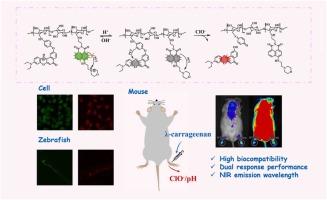Construction of a cellulose-based dual-responsive fluorescent probe for simultaneous pH and HClO detection and imaging in arthritic mice
IF 3.7
1区 化学
Q1 CHEMISTRY, ANALYTICAL
引用次数: 0
Abstract
pH and hypochlorous acid (HClO) are important active factors in living organisms and play a crucial role in the occurrence and progression of arthritis. Herein, a novel cellulose-based dual-responsive fluorescent probe was developed for highly sensitive and selective detect of pH and HClO. In the design, 4-(2-aminoethylamino) −1,8-naphthalimide and modified Nile red were grafted together onto a toluenesulfonyl actived cellulose to fabricate the cellulose-based probe. 4-(2-aminoethylamino) −1,8-naphthalimide was supplied as the pH-responsive part, and Nile red derivatives supplied as HClO-reponsive part, respectively. Upon decreasing solution pH, the cellulose-based probe exhibited 5-fold fluorescence enhancement at 560 nm. While, increasing of HClO concentrations resulted in remarkable fluorescence enhancement at 670 nm. The limit of detection (LOD) and limit of quantification (LOQ) for HClO were determined to be approximately 0.186 μM and 0.621 μM, respectively. The detection mechanism was explored by DFT calculation and HRMS analysis. Then it was successfully applied to detect pH and HClO within cells and zebrafish, and further validated in a mouse model of arthritis. The cellulose-based probe had demonstrated good biocompatibility, sensitivity, and prolonged fluorescence imaging capabilities (fluorescence stable for 3 h, over 50 % signal at 12 h). These results suggest the cellulose-based probe can potentially be used as a real-time monitoring tool for assessing clinical arthritis.

基于纤维素的双响应荧光探针的构建,用于同时检测关节炎小鼠的pH和HClO
pH和次氯酸(HClO)是生物体中重要的活性因子,在关节炎的发生和发展中起着至关重要的作用。本研究开发了一种基于纤维素的双响应荧光探针,用于高灵敏度和选择性地检测pH和HClO。在设计中,将4-(2-氨基乙基胺)-1,8-萘酰亚胺和改性的尼罗红接枝在甲苯磺酰基活化纤维素上制备纤维素基探针。4-(2-氨基乙胺)-1,8-萘酰亚胺作为ph响应部分,尼罗红衍生物作为hcl响应部分。降低溶液pH后,纤维素基探针在560nm处表现出5倍的荧光增强。随着HClO浓度的增加,在670 nm处的荧光增强显著。HClO的检出限和定量限分别为0.186 μM和0.621 μM。通过DFT计算和HRMS分析探讨了检测机理。然后成功应用于细胞和斑马鱼体内的pH和HClO检测,并在小鼠关节炎模型中进一步验证。纤维素基探针具有良好的生物相容性、灵敏度和长时间荧光成像能力(荧光稳定3小时,12小时信号超过50%)。这些结果表明,基于纤维素的探针可以潜在地用作评估临床关节炎的实时监测工具。
本文章由计算机程序翻译,如有差异,请以英文原文为准。
求助全文
约1分钟内获得全文
求助全文
来源期刊

Sensors and Actuators B: Chemical
工程技术-电化学
CiteScore
14.60
自引率
11.90%
发文量
1776
审稿时长
3.2 months
期刊介绍:
Sensors & Actuators, B: Chemical is an international journal focused on the research and development of chemical transducers. It covers chemical sensors and biosensors, chemical actuators, and analytical microsystems. The journal is interdisciplinary, aiming to publish original works showcasing substantial advancements beyond the current state of the art in these fields, with practical applicability to solving meaningful analytical problems. Review articles are accepted by invitation from an Editor of the journal.
 求助内容:
求助内容: 应助结果提醒方式:
应助结果提醒方式:


